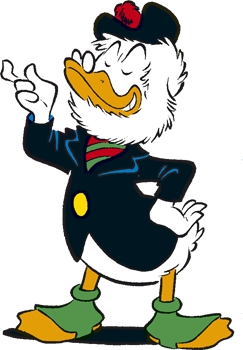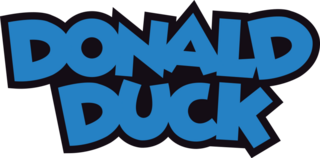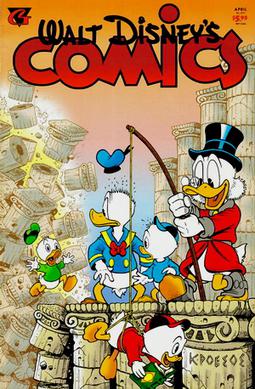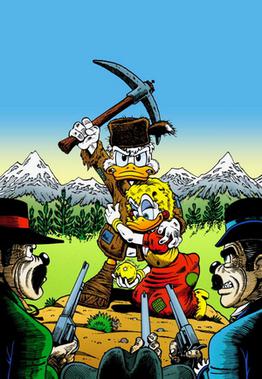Story
In the McDuck Clan ancestral castle in Scotland, Scrooge's father and uncle speak of Scrooge and his accomplishments, toasting to "the lad". Meanwhile, Scrooge has gone to Kalgoorlie, Australia, after hearing of gold being found there. In the middle of the desert, he rescues an aborigine wiseman, Jabiru Kapirigi, from being robbed by a highwayman.
Jabiru, or Jabby as Scrooge calls him, tells Scrooge that he is on a walkabout, reading the Dreamtime tale, and he wants Scrooge to join him. Scrooge, hoping to find gold where Jabby leads him, goes along. As the wiseman hands Scrooge a didgeridoo, Scrooge sarcastically replies "Great! Now I'm John Philip Sousa!", which Jabby takes literally, and hence, calls Scrooge by the name Jonflip Zooza.
Whilst blowing the didgeridoo, the sand beneath Scrooge crumbles to reveal an ancient cave. The two use a rope to climb down into the hole, where on the walls the Dreamtale is written. Jabby reads it aloud to Scrooge:
- "It tells of Kakadu the dingo, he steals the crocodile egg from its nest!
- But the great platypus chases Kakadu...
- ...and Irria, the black cockatoo, sends Bunyip, the water monster, after the egg thief!
- Bunyip chases the dingo...
- ...and the great platypus finds the sacred egg, but loses his firstborn in the fight!
Scrooge dismisses it all as "pure humbug", and asks Jabby if the cave holds any gold. There is none, but Jabby points to a giant opal. Scrooge wishes to buy it, but their rope is being hauled up by the highwayman. Having heard of the opal, he orders them to send it up, and he will let them climb out. When he has the opal, however, he just throws the rope down. He then steals Scrooge's camel and all his things.
To get out, Scrooge blows Jabby's didgeridoo to summon an emu, then uses the emu to chase after the highwayman. When he rides off, Jabby asks Scrooge if he will return the opal, but Scrooge gives no answer. Come morning, the highwayman is searching through Scrooge's belongings and finds some coins. One, tied to a string that "isn't even Aussie", is Scrooge's number one dime. He throws the coins away just as Scrooge catches up with him, and ties a rope around the thief. As they turn around, the coins, including the one dime, lie in the sand, forgotten.
They ride for some time, before a kangaroo stampede passes by them. The camel then runs off with the highwayman, but Scrooge falls off. He hears a roar in the distant and, looking in his spyglass, sees that it's a flash flood from the mountains. He runs for shelter, and just barely makes it to the Dreamtale cave, which is then sealed off by the water and wet sand. Come morning he can again leave, climbing out on the wet sand. He ponders taking the giant opal for himself, as no one will know for a hundred years, but decides that he wants to make his fortune by right means, and leaves the opal behind.
Much later, at the edge of the desert, Scrooge encounters Jabby again, sitting by a campfire at the end of another Dreamtale cave. Jabby knows that Scrooge returned the opal, and when Scrooge tells him that he had lost his number one dime, Jabby wonders if it was like his firstborn. It is, and Scrooge realises that he in fact is the great platypus from the Dreamtale. Scrooge realizes that the part of the Dreamtale that Jabby read him earlier actually foretold his adventure with the highwayman and the flash flood.
Jabby continues to tell Scrooge that the great platypus's firstborn was saved by Djuway, the bowerbird who builds his nest with shiny trinkets. Nearby is a bowerbird nest, and looking inside Scrooge finds his number one dime. Ecstatic, he wonders what else the Dreamtale says about the great platypus. As a reward for returning the egg (the opal), Scrooge is allowed to "see his dream through the crystal eye". Jabby casts sunlight upon a crystal of his, held by Scrooge against the wall of the cave. What Scrooge sees resembles the northern lights, and it tells him to go north of the Rocky Mountains, north to the Yukon.
As Scrooge leaves, singing happily to himself, Jabby looks at the Dreamtale, where there is a drawing resembling his money bin, and his nephews, Donald, Huey, Dewey and Louie. Jabby finds it confusing, and wonders what they have "to do with a poor, out of luck fossicker (prospector) like poor Jonflip".

The bunyip is a creature from the aboriginal mythology of southeastern Australia, said to lurk in swamps, billabongs, creeks, riverbeds, and waterholes.

Huey, Dewey, and Louie are triplet cartoon characters created by storyboard artist (screenwriter) Carl Barks for The Walt Disney Company from an idea proposed by cartoonist Al Taliaferro and are the nephews of Donald Duck and the grand-nephews of Scrooge McDuck. Like their maternal uncles, the brothers are anthropomorphic white ducks with yellow-orange bills and feet. The boys are sometimes distinguished by the color of their shirts and baseball caps. They featured in many Donald Duck animated shorts and in the television show DuckTales and its reboot, but comics remain their primary medium.

Scrooge McDuck is a cartoon character created in 1947 for The Walt Disney Company by Carl Barks. Appearing in Disney comics, Scrooge is a Scottish-born American anthropomorphic Pekin duck. Like his nephew, Donald Duck, he has a yellow-orange bill, legs, and feet. He typically wears a red or blue frock coat, top hat, pince-nez glasses, and spats varying in color. He is portrayed in animation as speaking with a Scottish accent. Originally intended to be used only once, Scrooge became one of the most popular characters in Disney comics and Barks' signature work. Scrooge is an extremely rich duck who lives in the city of Duckburg in the fictional US state of Calisota, whose claimed location is in California in the real-world United States.

The Life and Times of Scrooge McDuck (Lo$) is a serial of 12 comic book stories written and drawn by Don Rosa, lettered by Todd Klein, first published by the Danish publisher Egmont in the magazine Anders And & Co. from 1992–94 and later in English in Uncle Scrooge #285 through #296 (1994–96). The stories chronicle the in-universe biography of Scrooge McDuck before his introduction in 1947. The stories were later collected and published together in a single volume. Rosa later published additional stories which expanded on Scrooge's biography. These were released as The Life and Times of Scrooge McDuck Companion.

The Clan McDuck is a fictional Scottish clan of cartoon ducks from which Disney character Scrooge McDuck is descended. Within the Donald Duck universe, the clan is related to the American Duck family through the marriage of Hortense McDuck and Quackmore Duck, Donald and Della Duck's parents, giving both of them partial Scottish ancestry.

Gyro Gearloose is a cartoon character created in 1952 by Carl Barks for Disney comics. An anthropomorphic chicken, he is part of the Donald Duck universe, appearing in comic book stories as a friend of Donald Duck, Scrooge McDuck, and anyone who is associated with them. He was also a heroic creator star of the animated DuckTales. He first appeared in the Carl Barks comic "Gladstone's Terrible Secret", and was the regular lead character in 4-page backup stories in Barks' issues of Uncle Scrooge, starting with issue #13 and continuing through #41.

Magica De Spell is a cartoon character created in 1961 by Carl Barks for the Duck universe. An Italian sorceress, she constantly attempts to steal Scrooge McDuck's Number One Dime, which she believes will play a vital role in magically obtaining the same fabulous wealth of its owner.

Flintheart Glomgold is a cartoon character created in 1956 by Carl Barks. He is a South African American Pekin Duck and the business rival of Scrooge McDuck, usually portrayed as an ambitious, ruthless, and manipulative businessman who shares many of the same qualities as Scrooge—the drive for massive wealth, and the cunning and creativity to obtain the same—but he lacks any of Scrooge's tendencies towards generosity and compassion. In Don Rosa's The Life and Times of Scrooge McDuck, he is said to be a Boer.

The Donald Duck universe is a fictional shared universe which is the setting of stories involving Disney cartoon character Donald Duck, as well as Daisy Duck, Huey, Dewey, and Louie, Scrooge McDuck, and many other characters. Life in the Donald Duck universe centers on the city of Duckburg and is a part of the larger Mickey Mouse universe. In addition to the original comic book stories by Carl Barks, the Duckburg cast was featured in Little Golden Books, television series such as DuckTales (1987–1991), Darkwing Duck (1991–1992), and the DuckTales reboot (2017–2021), and video games such as DuckTales (1989), QuackShot (1991), Goin' Quackers (2000), and DuckTales: Remastered (2013).

John D. Rockerduck is a cartoon character created in 1961 by The Walt Disney Company for the Duck universe. He is one of Scrooge McDuck's main rivals in Disney comics. His name is a play on that of John D. Rockefeller, the American capitalist and philanthropist. Though a relatively obscure character in the United States, Rockerduck is an example of a character who has become notable in the foreign market, particularly in stories produced for the Italian market. He made his first animated appearance in 2019, in the second season of the DuckTales reboot.

"A Christmas for Shacktown" is a 32-page Disney comics story written, drawn, and lettered by Carl Barks. The story was first published in Four Color #367, and tells of Donald Duck's attempts to raise money for a Christmas party for the poor children of Shacktown.

"Return to Plain Awful" is a Donald Duck story that was originally printed during the Gladstone Publishing run of Donald Duck Adventures, issue #12 in May 1989. It was written by Don Rosa as a sequel to "Lost in the Andes!" by Carl Barks, to commemorate that story's 40th anniversary.

"The Second-Richest Duck" is an Uncle Scrooge comic book story written and illustrated by Carl Barks in February 1956. It features the first appearance of Flintheart Glomgold.

"A Little Something Special" is a 1997 Disney comics story created by Don Rosa to celebrate the 50th anniversary of Scrooge McDuck's first appearance in Carl Barks's "Christmas on Bear Mountain" in 1947.

"The Treasury of Croesus" is a 1995 Donald Duck comic story by Don Rosa. The story was first published in the Danish Anders And & Co. #1995-04; the first American publication was serialized in Walt Disney's Comics and Stories #601-603, in February-June 1996.

"The Prisoner of White Agony Creek" is a 2006 Scrooge McDuck comic by Don Rosa. The story takes place between "King of the Klondike" and "Hearts of the Yukon" in the series The Life and Times of Scrooge McDuck making it part 8B. The story shows how Goldie O'Gilt was taken to Scrooge's claim by the White Agony Creek. As Don Rosa announced his retirement in June 2008, this is his last story to date.

"The King of the Klondike" or "The Argonaut of White Agony Creek" is a 1993 Scrooge McDuck comic by Don Rosa. It is the eighth of the original 12 chapters in the series The Life and Times of Scrooge McDuck. The story takes place from 1896 to 1897 and deals with Scrooge McDuck who participates in the Klondike Gold Rush. It takes place before The Prisoner of White Agony Creek and The Hearts of the Yukon.
"The Duck Who Never Was" is a 1994 Disney comics story written and drawn by Don Rosa. It was written to celebrate Donald Duck's sixtieth anniversary. The story was first published in the Danish Anders And & Co. #1994-23; the first American publication was in Donald Duck #286, in September 1994.

















